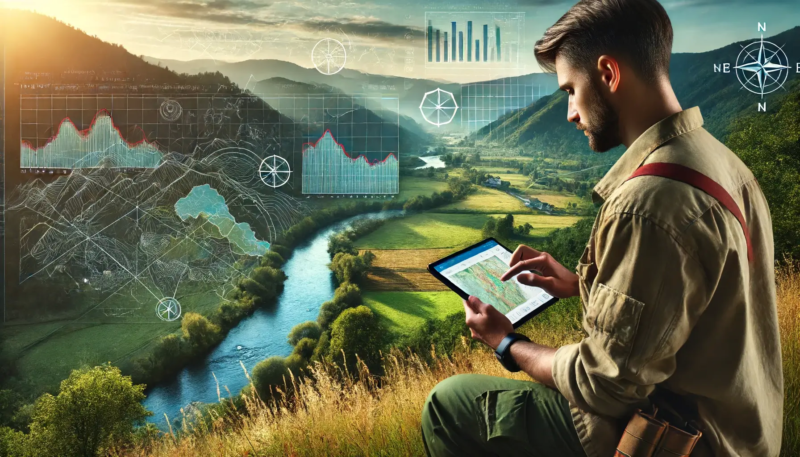
A GIS consultant is a professional who specializes in geographic information systems (GIS). They assist organizations in using this technology to address location-based issues, such as optimizing delivery routes, managing natural resources, planning urban development, tracking environmental changes, and improving emergency response strategies.
Their work involves collecting, analyzing, and visualizing spatial data to offer insights and aid in decision-making. GIS consultants are employed in a wide range of industries, such as government, urban planning, transportation, and environmental management.
Table of Contents

The field of GIS consulting is experiencing strong growth, with a projected 9% increase in jobs from 2018 to 2028, according to Zippia. This translates to roughly 56,000 new positions expected over the next decade. This positive outlook is reflected in salaries as well, with GIS consultants seeing a 10% increase in compensation over the past five years. Currently, the average GIS consultant earns $94,013 annually.
Contrary to the common myth that GIS consultants spend most of their time in the field collecting data, the reality is that much of their work is computer-based. They primarily focus on analyzing data, creating maps, and communicating with clients. While some fieldwork may be involved, particularly in industries like forestry or environmental protection, GIS consultants often rely on data collected by others.
While every organization might have its own unique set of requirements and job responsibilities associated with a GIS consultant role, but generally speaking, this is what you can expect:

GIS jobs are in high demand for several reasons, the most influential being the growing reliance on data for decision-making–especially given that much of that data includes a spatial component. As GIS consultants are able to analyze spatial data, they have become essential in providing insights that businesses can rely on for strategic direction. For instance, a retail company might use GIS professionals to determine the locations of their customers and strategically target their advertising efforts.
On the public side of the spectrum, governments are increasingly investing in GIS technology to enhance infrastructure, manage resources, and monitor environmental changes. Their investment has created a higher demand for GIS professionals to work on key public projects, analyzing spatial data and providing insights that guide public spending and conservation projects, especially when dealing with increased risk or natural disasters. Plus, GIS consultants can also help agencies comply with relevant regulations.
The tech sector has also been expanding its footprint on software, apps, and plugins that rely on geolocation–just think of everything from delivery apps and ride-sharing services to location-based games and even fitness trackers. GIS consultants can help guide the creation of these custom tools to address specific needs or these evolving technologies.
Overall, working with GIS technology is an exciting and dynamic field with the potential to make a positive impact on the world. If you’re struggling to understand just how varied jobs in GIS might be, this Reddit thread might give you some ideas, spanning from someone who helped NASA decide where to land the Mars rovers to ensure a safe landing; to a GIS consultant for a vineyard who analyzed soils, temperature, nutrients, yield, and microclimates; to someone who used their GIS skills to scan old Soviet maps of landmined areas and documenting what areas their teams had cleared of mines so they could be farmed.

To work as a GIS consultant means leveraging spatial data, analysis, and modeling to help organizations across industries make data-driven decisions, optimize operations, and solve complex geographic problems. All industries, from transportation to utilities to natural resources and technlogy employ GIS consultants to solve complex geographic problems:
Terralab GIS, a geospatial consultancy, assisted a client needing detailed data collection on infrastructure features and path quality/type for a specific city. The client initially faced challenges due to manual data handling and a poorly designed database.
A GIS consultant worked closely with the client to develop a standardized schema for their data. They efficiently transferred existing data into a new database and created automated processing models to clean, organize, and generate final products from the field data. This streamlined approach reduced the overall project delivery time by 30% and cut processing costs by 70%.
The same agency was also tasked with developing a conservation plan for a site using spatial analysis of threatened species data. They gathered and consolidated spatial data on the threatened species into a geodatabase, identified key ecological variables, and obtained relevant spatial layers.
Using this data, they performed spatial analysis to create species preference models, which were then combined and weighted to produce a comprehensive conservation model. The results were compared with existing vegetation to pinpoint priority conservation areas and locations needing improvement. The final plan included a series of raster and vector layers, which were published in maps and accompanied by a report interpreting the findings.
Riseup Labs, another agency offering GIS services, built an eCommerce platform to buy food and other household necessities using a web and mobile-based shopping service–a vry convenient way for busy families to get groceries, but also an essential service for the elderly and others with limited mobility or a lack of transportation.
Part of the challenge for this project was building their delivery app and the backend for Red Grocer, which required GIS work to allow users to track the location of their product using real-time GPS, which is one of the essential features of the delivery app.
GIS consultants use cloud-based platforms like Maptive to optimize delivery routes and analyze customer distribution patterns. This helps businesses identify ideal store locations, ensure convenient access for customers, and plan delivery schedules that minimize travel time and fuel costs.
GIS professionals can also streamline operations by optimizing delivery routes through data-driven analysis, minimizing travel time and fuel costs while reducing emissions. This approach not only improves efficiency but also supports environmental sustainability goals.
An intriguing case study from GIS in ecology illustrates how a GIS consultant employed spatial analysis to evaluate habitat connectivity among potential lynx patches in Scotland. This analysis was pivotal in assessing Scotland’s ability to sustain a viable lynx population in the event of reintroduction.
Another project examined the cetacean community around St. Helena Island, using GIS to map the distribution of cetacean species in the eastern tropical Atlantic, with the aim of supporting local conservation and management efforts. Although the project did not entail intricate GIS analysis, it exemplifies a common use of GIS: plotting data and generating maps for inclusion in publications, reports, and presentations.
GIS consultants are instrumental in tackling the energy crisis through their expertise in renewable energy, green infrastructure, and sustainable development.
They can leverage spatial analysis and real-time data to model scenarios and optimize site selection so that large infrastructure projects like wind farms can be planned through data-driven decision-making.
By identifying optimal project sites across wind, solar, and geothermal sectors, GIS consultants play a key role in expanding the footprint of the renewable energy sector, helping safeguard ecosystems, and alleviating the environmental crisis.

If you are passionate about using data to solve real-world problems, becoming a GIS professional can be an great career path. Whether you are planning your future career path as a young graduate, or already have some work experience and want to switch careers, entering the GIS field requires a few key elements.
Building a strong foundation in GIS experience is key to becoming a successful consultant. Here are some ways to gain valuable skills and showcase your abilities:
If you’re coming from a different field, don’t worry! Many transferable skills can be valuable assets in a GIS career, including:
By following these steps and leveraging your existing skills, you can position yourself for a rewarding career as a GIS consultant and make a real difference in addressing the energy crisis through sustainable practices.
Becoming a GIS consultant offers a dynamic and impactful career path, leveraging geographic information systems to solve real-world problems across various industries.
If you want to get started, Maptive is a user-friendly platform that allows you to begin learning GIS and build valuable mapping experience. Explore spatial data, create maps, and gain hands-on practice to see if a GIS career is right for you.
Try Maptive today and unlock the power of GIS!
Brad Crisp is the CEO at Maptive.com, based in Denver, CO and born in San Francisco, CA. He has extensive experience in Business Mapping, GIS, Data Visualization, Mapping Data Analytics and all forms of software development. His career includes Software Development and Venture Capital dating back to 1998 at businesses like Maptive, GlobalMojo (now Giving Assistant), KPG Ventures, Loopnet, NextCard, and Banking.
